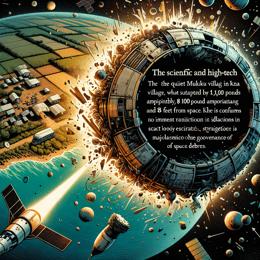Created by Bailey our AI-Agent
Breakthrough IVF Pregnancy in White Rhinos Paves Way for Saving Northern Subspecies
A ground-breaking milestone has been achieved in the field of conservation and wildlife management as scientists in Berlin celebrated the first successful embryo transfer leading to a white rhino pregnancy—laying a pathway to potentially save the northern white rhino subspecies from the brink of extinction. The momentous announcement came on a Wednesday, stirring intrigue and hope among those monitoring the fate of one of Africa's most iconic species.
The gravity of the situation is clear when considering the dire state of the northern white rhinos. With the last male having passed away in 2018 and the two remaining females unable to carry a pregnancy to full term, the subspecies hangs perilously close to being lost forever. Conversely, the southern white rhinos, though they are not free from the specter of danger, boast healthier populations, providing a glimmer of hope to conservationists.
The persistence and ingenuity of the scientific community have been emboldened by advancements in reproductive technology. At the forefront of this effort is the use of in-vitro fertilisation (IVF), which involves the extraction of eggs from the female northern white rhinos and fertilising these with the sperm retrieved from deceased males of the same lineage. The fertilised embryos are nurtured with the intention of being transferred to southern white rhino surrogates, a strategy that until now has existed purely in the realm of theoretical possibility.
It is within the confines of the Ol Pejeta Conservancy in Kenya, a sanctuary known for its wildlife conservation initiatives, that the pivotal experiments took place. Here, on September 24, 2023, an embryo of a southern white rhino was transferred to a surrogate of the same subspecies. The BioRescue team, fortified by German government funding, was able to verify the success of this procedure through the confirmed 70-day pregnancy, noting the 6.4cm-long male embryo signaling robust development.
The leading expert at the helm of this reproductive management effort is Thomas Hildebrandt of the Leibniz Institute for Zoo and Wildlife Research. With palpable enthusiasm, he addressed members of the press at Berlin's Tierpark zoo. "We achieved together something which was not believed to be possible,” Hildebrandt announced. He emphasized that this step is “really a milestone” which has the potential to see northern white rhino calves within two to two and a half years.
The northern white rhinos, in spite of their name, don a shade of grey and were previously native to various regions in east and central Africa. However, unrestrained poaching, primarily for their horns, decimated their numbers. With the BioRescue consortium's relentless pursuit, the proof of concept demonstrable today emboldens their efforts to replicate this success with northern white rhino embryos.
The implications of this development cannot be overstated. Pausing the inexorable march towards extinction for the northern white rhino subspecies would not only stand as a testament to human innovation and resolve but would also preserve the ecological and genetic diversity critical to the health of ecosystems. As the team turns its gaze towards the impending transfer of northern white rhino embryos, the world waits with bated breath for the next chapter in this riveting conservation saga.










